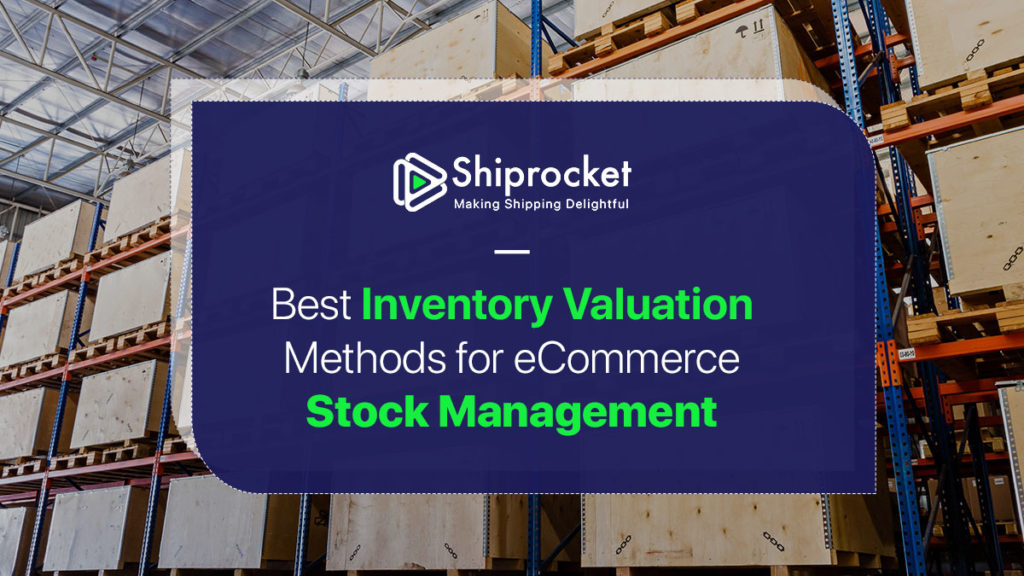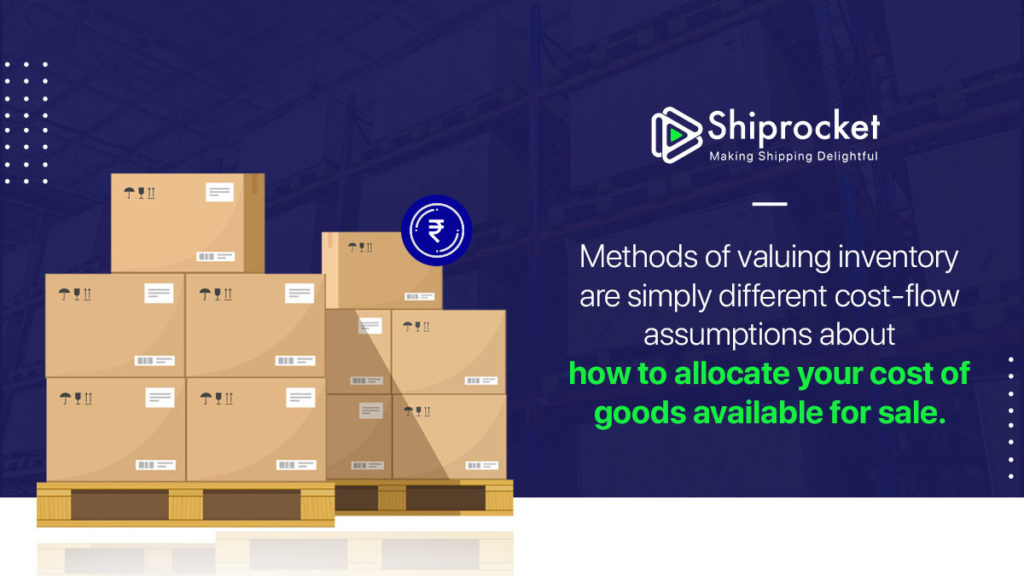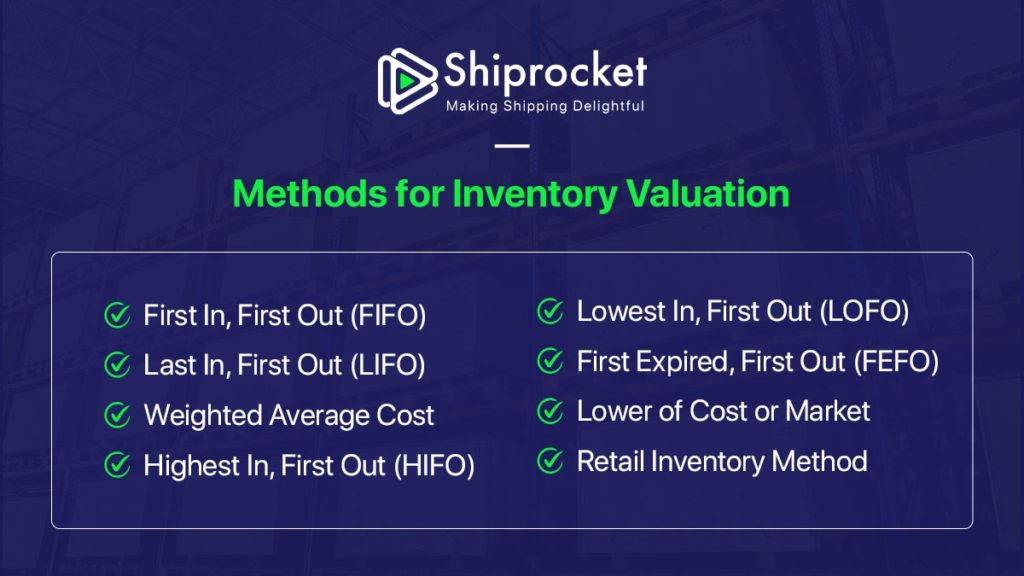Most Widely Used Methods of Inventory Valuation
- What is Inventory Valuation?
- Why is Inventory Valuation Important?
- Objectives of Inventory Valuation
- Gross Profit
- Financial Position
- What is First In, First Out – FIFO?
- What is Last In, First Out – LIFO?
- What is Weighted Average Cost?
- What is Highest In, First Out – HIFO?
- What is Lowest In, First Out – LIFO?
- What is First Expired, First Out – FEFO?
- What is Lower of Cost or Market?
- What is Retail Inventory Method?
- Conclusion
The word inventory scares many online sellers. And that’s because if you leave it unchecked, it’ll turn your entire business upside down. The point is that inventory has to be checked from time to time so that you know what’s actually going on in your warehouse. Since it is what represents your business to the customer, once your package delivers, you must ensure that you have adequate stock of the highest quality at all times.

What is Inventory Valuation?
Inventory valuation is a practice that helps in this. It is an accounting practice that is followed by organizations to keep an eye on their stocks. In other words, it helps them prepare their financial records effortlessly. Regardless of the size of your business, if you’re selling physical products, you have to record their whereabouts and this is because your inventory possesses some financial value.
It might seem small to keep on adding and updating the value of inventory for the purpose of accounting. But in fact, when you keep on doing it for a period of time, it determines your inventory ratio turnover and helps you plan your further inventory purchase decision accordingly.
For example, if you sell T-shirts to your customers and you’re left with 100 of them at the end of the financial year, you’ll have to record them in your balance sheet. As a result of this, you will buy the stock of T-shirts 100 less than what you have in mind. This is because it is always advisable to sell out the sitting stock before purchasing anything new.

Why is Inventory Valuation Important?
Inventory valuation doesn’t just mean that you keep an account of your sold and unsold stocks. This is just one step of the way. In fact, you have to also fix a rate to multiply your leftover stock from the year. While this helps in determining your gross profits for the year, it also has some issues involved in the calculation.
The stock that is left at the end of the year must have been bought at different points in time. For example, while you might have bought 20 pieces in January, you might have bought another 20 around June, 30 in August, and so on. There is a great possibility that the prices of all these would have been different during different months. Therefore, how do you calculate the overall amount associated with the leftover stock at a common rate?
These situations can leave you in a dilemma and impact the calculation of your gross profits, which is why you need to know about inventory valuation methods.
Objectives of Inventory Valuation
Inventory consists of goods that are meant for sale (unsold goods). In manufacturing units, it also includes raw materials, semi or unfinished goods, and finished goods. Inventory valuation is generally done at the end of the financial year to calculate the cost of sold and unsold goods. This is a crucial activity as the shortage or excess of inventory can affect the product, profitability, or success of a business.
Let’s take a look at the objectives of inventory valuation:
Gross Profit
Inventory is used to find the gross profit a company has earned during a financial year. Notably, gross profit is the cost of sales more than the cost of goods sold. To determine the gross profit, the value of the sold goods is matched with the revenue earned during the financial year.
Cost of Goods Sold = Opening Stock + Purchases during the year – Closing Stock
Financial Position
Closing stock is termed as a current asset in the balance sheet. The value of closing stock helps ascertain the financial position of the business. Notably, overvaluation or undervaluation can give a false picture of the working capital or overall business position in the balance sheet.
Let us know take a look a the top inventory valuation methods below-

What is First In, First Out – FIFO?
The first in first out is the one of the most popular inventory valuation methods. You ‘re probably already using it in your business even if you’re not familiar with the term. FIFO means that the oldest inventory that is sitting in your warehouse should be sold first. So, if you bought a stock in January and another one in August, you will first aim to sell the stock from January. Since the prices rise with time in most of the cases, the inventory that you’re left with is valued higher at the recent costs. Similarly, the cost of your goods sold becomes lower as it is based on the cost of the earlier inventory. In the end you have more profits to show in your balance sheet, ultimately leading to a higher taxable income. FIFO is also popular because it shows common sense in running a business. You don’t want your inventory to keep on sitting for long, which is why you sell it first.
What is Last In, First Out – LIFO?
The Last in first out method is the opposite of FIFO. in this method, you sell the inventory that comes in last in your business. So, if you’ve purchased one stock in February and the other one in November, you will first sell the November stock. It improves the matching state of your current business costs, but it is not suitable in general case scenarios. With this the cost of the goods is higher and thus the gross profits are taxable and income are lower.
What is Weighted Average Cost?
Yet another inventory valuation method is weighted average cost. It assumes that you sell all your goods at the same time. This is usually for the goods that have a similar price and are indistinguishable over a period of time. Therefore, the common price for these is averaged over the period. An example of this is crude oil.
While these are some of the common inventory valuation methods, there are also some uncommon methods. Take a look below-
What is Highest In, First Out – HIFO?
This type of inventory valuation is based on the point that your most expensive goods are sold first. This means that if you have a higher priced good in your inventory and a lower priced good at the same time, you will first sell the former. It is also good from the point of the efforts of a salesperson, since businesses try to sell their expensive products first. This inventory valuation method gives an instant bump to your short term revenues. But, in the overall case, our gross profits and taxable income drops. Moreover, your ending inventory is also lower.
What is Lowest In, First Out – LIFO?
This is the exact opposite of HIFO. In this inventory valuation method, your lowest price goods sell first. In other words, you sell your cheapest inventory before anything else. Your cost of goods is lower and your ending inventory ends up higher in this method. It might seem like your short term revenues are dropping with this, but ultimately it is a boost for your gross profits and taxable income.

What is First Expired, First Out – FEFO?
If you’re in the food business, this makes absolute sense. You’re probably already doing this in your business. The items that are about to expire first are the ones that must be sold out. This is to avoid any losses in your business. It is typically used in the food industry and ignores the effect of prices along with the dates on which they were purchased. As a result, your overall cost of goods will vary in this case.
What is Lower of Cost or Market?
This inventory valuation method is not based on the cost factor. It states that you should evaluate your inventory based on the lower factor out of the original cost or current market price. This method is used in cases where the inventory has been held on for a long period of time or has even become damaged and obsolete.
What is Retail Inventory Method?
In this method, your inventory units are not used. Instead, you take the total retail value of the goods you have. With this, you subtract their total sales and then multiply this value by the cost to retail ratio. This is a popular technique used in the handicraft business.
Conclusion
Most of the organizations selling physical products mostly use FIFO or LIFO, depending upon their requirements. However, whatever method you adopt, make sure it aligns with the goals you’re trying to achieve with your business. Most organizations end up with damaged inventory because their warehouse practices are not good enough. If you’re a small business and struggling with this, it is best advised to hire a 3pl fulfillment service for the task. For example, Shiprocket Fulfilment can help with warehousing and packing services at the lowest costs. This way you can focus on decision making, while your inventory is safely stored, picked, packed, and shipped to your customer.






